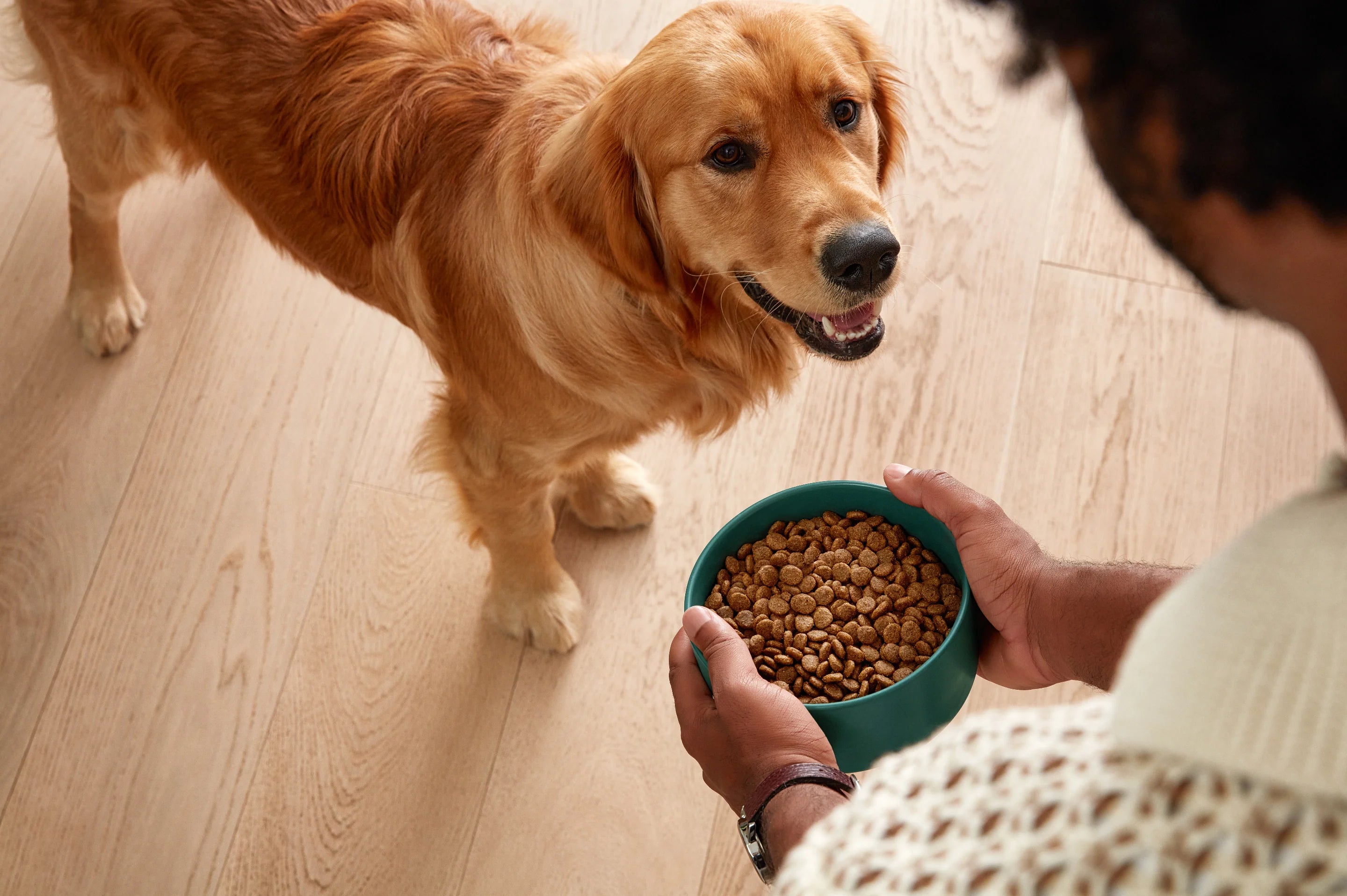As pet parents, one of our jobs is to help our pups stick to a healthy weight. Maintaining a healthy weight for dogs is important for longevity, heart and joint health, and reducing the risk of health problems in the future.
But how do you know if your dog is at a healthy weight? We spoke to Dr. Tammie Pearce, a licensed veterinarian at AskVet, about the most important things to consider for maintaining a healthy dog weight, from exercise to treats and diet, and what to do if you think your dog is overweight. Let’s dive in.
The Rise of Obesity
Unfortunately, obesity in dogs is at an epidemic level, just like it is for their pet parent counterparts. Some pups become more obese because of health problems, like painful joints, causing exercise to be a challenge.
Obesity in pets can cause additional health problems like:
- Irregular blood pressure
- Diabetes
- Liver problems
- Pancreatic issues
- Worsen joint problems
Determining Your Dog’s Weight
Wondering how to tell if your dog is overweight? You’re not alone. When it comes to the ideal dog weight, there is a whole orchestra of factors to consider. What’s perfect for one pup may be underweight or overweight for another. Even within the same breed, you can have huge variations in ideal weight with different physiques and metabolic needs.
How much your dog should weigh will depend on other factors like:
- Age: Puppies grow fast, and then typically plateau with their ideal weight changing into their senior years.
- Sex: Generally, males tend to be heavier than females, but not always.
- Body type: Some dogs are naturally muscular, like Boxers, while others are much more slender, like Whippets.
- Underlying health conditions: Certain conditions can affect weight, so it’s crucial to speak with your vet if you notice unexpected weight changes.
The age and life stage of your furry companion influences their healthy weight goal. Whether you have a lively young pup or a more senior dog (but just as cuddly), a healthy weight is important for leading a happy and active life. Determining your puppy’s weight, age, and nutritional needs is important to get the best start possible.
Unsurprisingly, weighing your dog at home can be tricky, especially with a large dog. For small dogs, you can use your bathroom scale. If your dog fits in your arms, you can weigh both of you and subtract your weight. Toys may be necessary for encouragement! Alternatively, the easiest way to weigh your dog is to go to your local vet, as they usually have doggy-sized scales available. It’s common for vets to weigh your dog during their yearly check-up.
The best way to determine if your dog is tipping the scale in the wrong direction is to have your pet evaluated by a veterinarian. They will compare key components of a body condition scoring chart to determine if your pet is carrying a few extra pounds. Body condition scoring is a system to help you work out if your dog is at a healthy weight, focusing on the tummy, ribs, and waistline. Instead of looking for a specific number on a scale, body condition scoring allows vets and pet parents to make more informed decisions about their pup’s health.
Profile Analysis
Checking your dog’s body condition is a simple way to see if they are in good shape, and this is something that you can do at home.
To start, you want to be on the same level as your dog so you can evaluate them from the side. A general rule of thumb is that the tummy should be higher than the ribcage. So, looking from the side, the belly should gradually incline from the front legs to the rear, with a noticeable tummy tuck. In an underweight dog, you likely see a much steeper incline. On the other hand, an overweight dog would have either no incline at all or a very shallow one.
Rib Examination
Is my dog too skinny or is my dog overweight? What’s the ideal weight for my dog’s breed and age? It’s normal to have questions about our furry family members; we want them to live healthy and happy lives, and a healthy weight is a crucial part of that. By combining a visual and physical assessment while considering your dog’s individual characteristics, you can start to get a good idea of your dog’s shape.
Another important area for assessing dog weight is the ribs. To examine the ribs, gently spread your fingers and rest your hands on your dog's back, following the curve of the ribs. By using your hands as part of the assessment, you can properly feel for the ribcage and fat instead of relying on a visual exam alone.
Here’s a general guideline on how to assess your dog’s ribs:
- Healthy weight: You should easily be able to feel the ribs with slight pressure.
- Underweight: Easily feel the ribs without pressure.
- Overweight: Difficult to feel ribs even with pressure.
Overhead Inspection
The next step is to perform an overhead inspection to assess your dog’s shape from above. A dog with an ideal weight will look a little like an hourglass shape; their waistline will be slightly narrow, and the waist should be behind the ribs.
If you can see your dog’s ribs and the waist is narrower than the ribcage, your dog may be underweight. But if you can’t see the waistline from this angle or your dog looks barrel-shaped, they could be overweight.
What If My Dog Is Not an Ideal Weight
So, you’ve assessed your dog’s body condition, shape, and weight and are concerned. Maybe you think they're underweight or overweight, or just need some guidance. Don’t panic; you can take steps to help your furry friend reach and maintain a healthy weight.
The best place to start is by speaking with your vet for a consultation. A vet can assess your dog’s weight and begin to pinpoint the cause of the issue. They might ask you about your dog’s exercise habits and diet and consider potential health issues that could cause weight changes.
A weight guide for dogs needs to take into account a number of factors, and your vet is the best person to guide you on recommended daily calorie intake and exercise regime. Many vets have a dog weight chart that shows a healthy weight range for different breeds. Depending on whether your dog is overweight or underweight, your vet may suggest changes to diet, treats, and exercise, and provide information on local weight management programs you can join for extra support.
Need More Advice? Ask a Vet
If you’re concerned about some extra pounds on your beloved pooch, Dr Tammie has the lowdown on what to do.
“When considering weight loss in dogs, it’s important to remember that one pound on a medium pooch is equal to ten pounds on a human. So be patient when trying to get your pet to lose weight; just remember how hard it is to shed TEN lbs. yourself. Weight loss in dogs is very similar to humans –eat less and exercise more. You can even join in the weight loss challenge yourself and make it a furry family affair.”
Food
“Most dogs can maintain their weight with moderate exercise daily, a decrease in high-calorie treats and a slight reduction in the daily portion of pet food (no more than a ¼ cup reduction at a time). Feeding your pet a healthy diet, with probiotics, like Jinx, is a great start.”
When it comes to weight loss in dogs, just like humans, you’re looking at changes to food and movement. But that doesn’t mean the treats have to stop! You can still train and treat your dog without breaking the diet by using low-calorie treats, like our range of dog-approved training treats that are under two calories each.
Exercise:
“If you are trying to increase exercise—do it slowly. No one just up and runs a marathon. You have to start small and build up! If your pet is a couch potato, then start with a slightly longer walk or three short walks per day. Three 10-minute walks can add up fast! Increase the length of play and vary the activities so you both enjoy the exercise.
Remember to exercise both mind and body by doing some “obedience” or agility/therapy-like training with balance tables and balls or consider a doggy gym/therapy school for additional activities.”
Weighing Up the Evidence
Our pups need a well-balanced diet to be fit and healthy. Every dog has individual needs, so the perfect diet and ideal weight will depend on their age, activity levels, size, and taste preferences.
If your dog is underweight, it could be due to a combination of overexercising or not getting enough calories from food. Dogs with high energy demands need proper nourishment to fuel their active lifestyle, with the right balance of nutrients. It’s important to choose a high-quality food specifically formulated to give your dog plenty of energy and nutrients to not only get back to a healthy weight but also support their lifestyle.
However, if you find that your dog is overweight, your vet may recommend gradually increasing exercise and reducing the portion size of high-quality dog food like Jinx. Just like humans, portion control is important for dogs as it helps prevent overeating and supports healthy growth and longevity.
If you’re trying to help your dog lose weight, try reducing or ditching the table scraps. Those human treats can be a sneaky source of calories and pack on the pounds fast. Instead, swap out human food for healthy dog-friendly snacks as well as non-food treats like toys, outdoor adventures, and trips to the park.
At Jinx, we know that your pups are part of the family. That’s why we work with dog nutritionists and vets to bring you real dog food to fuel real life. We’ve got the nutrition covered so you know that your furry best friend is getting all the nutrients they need for a healthy and happy life.
Whether you’re trying to help your dog lose or gain weight, be patient and try to make it fun. With some small adjustments, you can continue to keep your dog engaged and still do all those things you love to do together.

